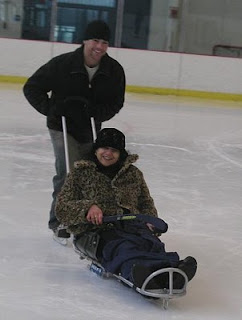I managed to squeak in one cross country skiing experience in last week's snow, a fabulous 3 miles through the woods on the shadowy side of a mountain that held diminishing conditions longest. Now I'm looking forward to visiting the
Weston Ski Track for my first sitski outing of the season. In anticipation, here's a primer on sitskis and basic technique.
Sitski Equipment
Nordic sitskis consist of a metal frame mounted on cross country skis, with a plastic or sling seat, allowing the legs to extend forward in either a straight or bent position. Sitskis models used in our Universal Access Program are not currently being manufactured, so if you are looking to purchase a sitski, I recommend checking out
Sierra Sitskis, which seem to be popular among serious users and can be ordered for custom fit. Sierra Sitskis are shown in these photos from last year's Vasalop Ski Race at the Weston Ski Track.
On our older sitskis, I maintain a base coat of wax on the skis for protection and recommend the application of glide wax from tips to tails just prior to use for maximum glide. Glide wax can be applied periodically throughout a ski session as needed - the sitskier has to intentionally or accidentally tip over so the application can be made by another person, although I'm sure some sitskier somewhere has probably mastered self application by now.
Ski poles need to be shorter than for standskiers. Once someone is in the sitski we generally offer poles up to head height in length. The longer the pole, the more power on uphills, but it may take awhile to work up to that length or longer. Poles can be cut to size using a hacksaw and the handles removed by soaking in hot water and re-glued on to the shortened pole.
We also supply a fanny pack with sitskiers, usually worn by an able-bodied ski partner, who may ski alongside or behind the sitskier, providing as much or as little assistance as needed. The fanny pack contains a tether with carabiners, glide wax, an emergency space blanket (very helpful when it is snowing as sitskis tend to capture more falling snow in their laps than standskiers), trail maps, and any other additional supplies that might be needed.
Sitskiers with strong upper bodies in good physical condition will want to ski as independently as possible. On a groomed course this may be 100% of the time. On more rugged terrain an assisting standskier is essential for support, providing uphill boosts from behind or pulling support on long upgrades using a tether. Supplemental braking is helpful security on long downhills - the standskier holds a tether clipped to the back of the sitski. Working in tandem allows many sitskiers to travel further and work out more efficiently than going solo, building strength and endurance for improved independent skiing.
Basic Sitskiing Technique
Forward propulsion is achieved through poling techniques. Double poling uses both arms together simultaneously for quick short forward bursts suitable for flat or moderate terrain. Arms alternate in single poling, which is less powerful but has advantages on long gradual upgrades as there is steady forward propulsion. People with torso strength can take some strain off their arms and shoulders by leaning far forward and using a hip thrust powered by abdominal muscles as a power source for speed. For this a straight leg ski offers the biggest angle between upper and lower body for greatest power. Bent leg skis help those without as much torso strength sit more securely in the ski and use their bodies to best advantage.

Braking occurs by leaning forward and turning the pole handles down into the snow so they drag and slow momentum. (When sizing a person to a sitski it is important to make sure their hands can reach the ground!) While skiing downhill, this technique can be used on one side to help steer the ski through curves, much like in sledding. Turning while skiing is done more gently through leaning the body and making poling adjustments. Turning while stopped is an art form requiring an upwards hop and torso twist while pushing off on angles with ski poles. On packed snow with an icy quality, sitskiers can do a 180 degree turn much faster than standskiers.
Being closer to the ground makes falling a lot easier. Ruts in the trail can tip an unprepared sitskier over sideways. My typical fall is an intentional wipeout on a steep downhill if I pick up more speed than I can manage. After falling on a downhill, it is important to twist yourself in the ski so you return upright in a perpendicular position to the downslope, giving yourself a chance to pause safely before turning to continue downhill. To right yourself after falling, place both poles in one hand and push yourself up, allowing your head to stay low then move into proper alignment once the sitski is back in an upright position. Best to practice this on flat ground to get the hang of it first. Don't forget to add more glide wax while you are down!
New Adaptive Ski Program in Boston!
Anyone in the Boston area or beyond interested in learning to sitski should know about a brand new adaptive Nordic skiing program starting up at the Weston Ski Track this winter. The New England Nordic Ski Association has recently formed an adaptive program and will be running programs twice a week: Mondays from 6:30-8pm (night skiing after work!) and Thursdays from 2:30-4pm starting January 31 through March 3. To find out more, contact Eileen Carey at 207-514-3230.











